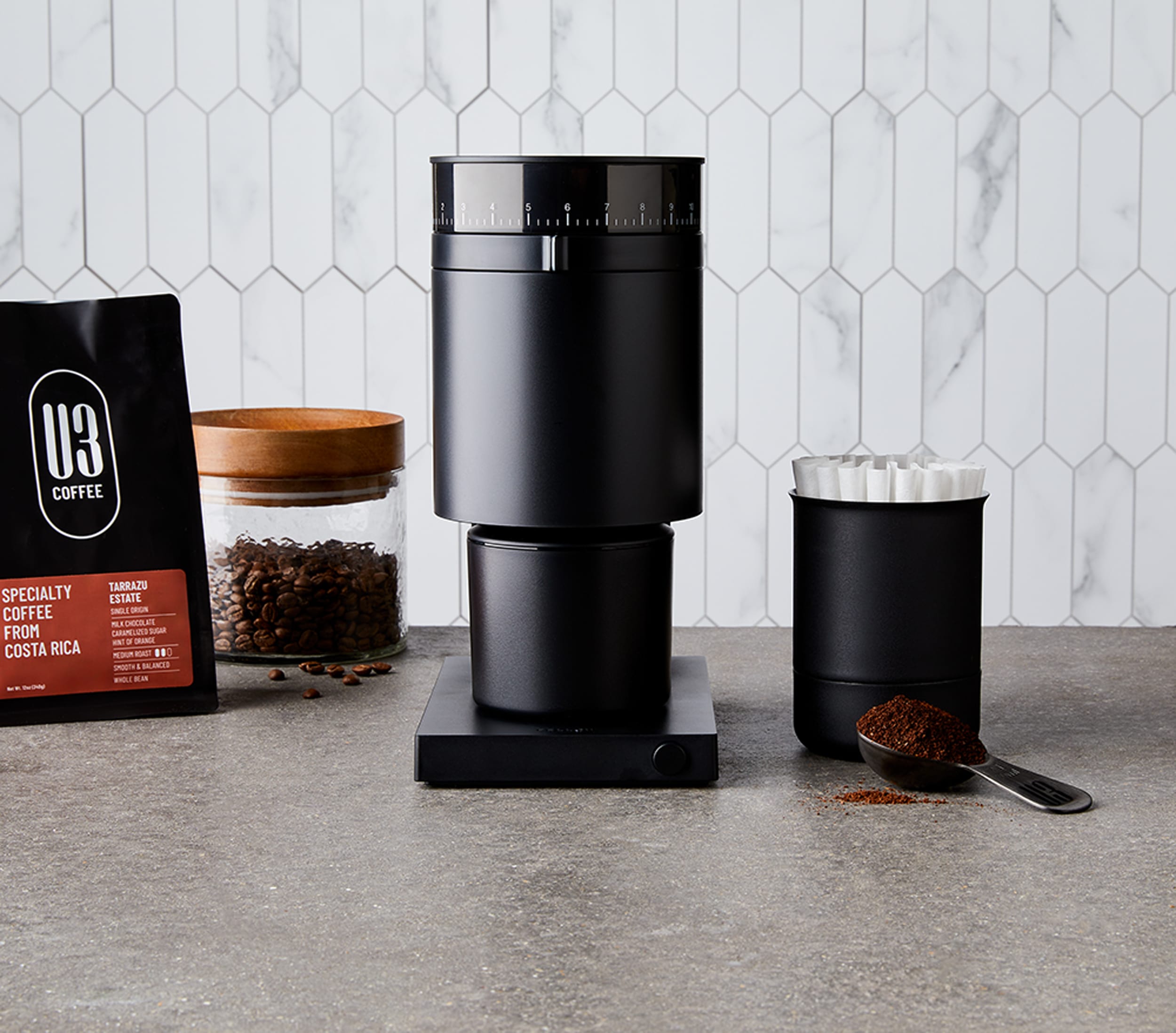
Cleaning a Coffee Grinder 101
A dirty grinder can muddy the taste of your coffee, so cleaning your coffee grinder regularly is vital.
Maintaining your coffee grinder means cleaning any part that touches coffee—from the exterior to the burrs or blades to the seals.
While you may hear that grinding rice is a great hack for cleaning your blades or burrs, we don’t recommend it because it could damage your machine.
Picture this: the sun streaming through your kitchen window, the tantalizing aroma of your favorite beans wafting through the air, and the promise of that first perfect sip. Before you dive into that blissful morning routine, though, you’ve got to grind those beautiful beans.
We’re here to tell you: If you’ve got a dirty grinder, you could be tainting the taste of your favorite roast.
We believe every roast deserves its moment to shine, so let’s talk about a crucial but often overlooked aspect of coffee craftsmanship—cleaning your grinder. It’s not just about appearances; it’s about preserving the essence of your favorite brew. So grab your cleaning gear and dive into our step-by-step guide to cleaning a coffee grinder!
How to Clean a Coffee Grinder: The Basics
Cleaning your coffee grinder isn’t about aesthetics—it’s an integral part of maintaining your equipment. A top-notch burr grinder, for example, is an investment, one that can last a lifetime if properly cared for. Proper care can significantly extend the lifespan of your grinder.
You can find our favorite grinder, the Fellow Opus Conical Burr Grinder, in the U3 Exchange!
Each grind leaves behind fines that, over time, start to build up in the grind bin and burrs. Eventually, those grinds can impact your grinder, making it work less effectively and clogging it, which can require expensive repairs—or even destroy your machine.
Whether you’re using a high-end burr grinder or a simple, economical blade grinder, cleaning helps ensure that your favorite beans taste their best. Even if your beans don’t have a shiny surface, all roasted coffees contain oils; they’re a large part of what gives the coffee its unique flavor. When you grind your beans, those oils are released and leave residue on grinding elements. Over time those oils can go rancid, which can negatively affect the taste of your coffee, but even in the short-term, if you’re switching between bags, the oils from one roast can affect the taste of your next batch.
What Parts of a Coffee Grinder Require Cleaning?
The simple answer is: if it touches your coffee, it will need cleaning. Depending on the kind of grinder you have and the model, you may or may not have all of these parts. Your owner’s manual is going to be your best friend in this process, because it’ll give you a detailed diagram of your specific grinder. In general, though, here are the elements we’re talking about when cleaning a coffee grinder:
- Hopper: This is the container where you pour in your whole beans. Coffee oils and dust can build up here, impacting freshness and flavor.
- Grind chamber: This houses the burrs or blades. When grounds accumulate in the crevices, they can cause the motorize parts to malfunction or even burn out completely.
- Burrs and blades: These do the actual work of grinding the beans and need thorough cleaning every few months to prevent oils and grounds from building up, which could affect the flavor of your coffee and the functioning of your grinder.
- Grind bin: This the area that holds the ground coffee and needs regular emptying and cleaning to prevent oils and leftover grounds from building up and affecting the flavor of your coffee.
- Gaskets and seals: These prevent leaks and ensure a proper seal, which can be disrupted by the buildup of dust and oils.
- Exterior: Even though the exterior of your grinder has limited contact with your coffee, over time, it can still end up covered with oils and grounds. Coffee oils can damage and stain the finish, and dust and grim can get caught and build up in crevices around the buttons and switches, which can prevent them from working smoothly.
Tools for Cleaning a Coffee Grinder
- Owner’s manual: Don’t start the process of cleaning your grinder without your owner’s manual in hand. Not only will it tell you which elements of your grinder can be disassembled for cleaning, it’ll also give you a road map to get it put back together again—which is kind of important.
- Microfiber cloth: This is your go-to tool for wiping down the exterior, hopper, and grind bin.
- Grinder brush:This specialized brush helps reach tight spaces and remove grounds from burrs (for burr grinders). Some grinders might come with one, but you can also use a soft bottle brush if it doesn’t scratch the burrs.
- Grinder Cleaning Tablets: Grinder cleaning tablets are great for keeping things running smoothly on a regular basis without having to disassemble anything. These help soak up any oily residue inside the grinding chamber and keep the coffee flowing. Urnex’s BioCaf tablets are also biodegradable, gluten and phosphate free.
- Compressed air (optional): This can be helpful for blasting out stubborn coffee particles, especially from hard-to-reach areas.
- Soft brush: If your grinder doesn’t come with a dedicated brush, a soft toothbrush can work for cleaning the burrs, blades, or other tight spaces. Just make sure it’s clean and dry.
- Pipe cleaners and toothpicks (optional): Like to really get into every nook and cranny? These household items can help—just make sure that you’re being careful so they don’t leave behind shards of wood or metal.
- Dish soap: This is only for cleaning the grind bin and the hopper—never use it on the burrs or blades, where moisture can lead to rust.
How to Clean a Coffee Grinder
Once you’ve gathered your tools, you’re ready to dive in! Whether you’re cleaning a burr grinder or a blade grinder, our cleaning guide has you covered!
1. Unplug Your Coffee Grinder
We believe in safety first! Whether you’re cleaning a blade grinder or a burr grinder, your appliance is designed to pulverize hard coffee beans, so let’s not take any chances! Before you start the process, turn off the grinder and unplug it to avoid any preventable accidents.
2. Empty the Grind Bin and the Hopper
Before we get down to the deep clean, we want to eliminate all the extra, easy-to-remove grounds so that we can focus on the detailed cleaning. Give your grinder a gentle tap and shake over your trash can or, even better, your compost bin.
3. Disassemble Your Coffee Grinder
Consult your owner’s manual to figure out which parts of your grinder can be removed for cleaning. In some cases, it’ll just be the removable lid or bin, but many grinders are designed to allow you to separate the hopper, burrs/blades, grinding chamber, and bin for detailed cleaning.
4. Brush Clean All the Internal Elements of Your Coffee Grinder
Grab your brush and gently remove any coffee grounds clinging to the chamber, burrs, and blades. If you have a burr grinder, be sure to use your burr brush or bottle to clean between the burrs, not just the external surfaces. You can also use a can of compressed air to blast away stubborn bits. And if you’re really into the fine details, a toothpick or pipe cleaner can help you get into all the nooks and crannies of your burrs and hardware.
5. Wipe Down the Inside of Your Grinder
Use a dry microfiber cloth to wipe down all of the grinding components, the grind bin, and all the gaskets and seals. We want to clear away all of the fine grounds you’ve just loosened up. Some fastidious cleaners go the extra mile by using a vacuum with an extra-small crevice attachment to suck up all the dust—and we respect that kind of dedication!
6. Clean the Washable Parts
Check your owner’s manual to see which parts are safe to wash with water, and hand wash them with mild dish soap and warm water. Be sure to rinse them thoroughly (we don’t want any of that sudsy residue ending up in our morning cup), and dry them completely. And remember, do not use water to clean your burrs or blades—this can create rust. And be sure to keep the base, which holds the motor, dry too!
7. Buff the Exterior
Use another dry microfiber cloth to wipe down the exterior of the grinder to get rid of coffee oils and residue and leave it looking shiny and new. You can also use a toothpick to clear out any open crevices around the buttons or dials—just be careful not to get overzealous so you don’t end up with a wooden shard lodged in the space.
8. Reassemble Your Coffee Grinder
Once all of the components you washed are completely dry, it’s time to put everything back together. Double-check your owner’s manual to make sure it’s all back where it belongs and that all of your parts are properly aligned.
9. Run a Test Grind
Once you’ve got your grinder reassembled, plug it in and grind a small amount of beans (10–30 mg). We know, you’re probably thinking, “Wait, I just spent all this time trying to eradicate all the grounds! Why would I want to add more now?” Turns out that even though we want to remove old oils so they don’t affect the taste of our fresh coffee, the fresh oils are actually helpful to your grinder—they keep it running at its best. Think of it like seasoning a cast-iron pan; those oils are protecting the metal and preventing it from oxidizing Plus, by doing a test grind, you’ll ensure that everything is put back together properly before the pressure’s on. Be sure to toss out the test grind when you’re done.
10. Enjoy!
You’re ready to grind up your favorite roast, knowing that the results will be perfectly flavored and clean!
How to Maintain a Coffee Grinder
A freshly cleaned grinder is truly a thing of beauty, so we recommend making deep cleaning a regular part of your routine. Blade grinders benefit from a monthly cleaning, while burr grinders can wait a bit longer—aim for every 3 months. The key to keeping your grinder in tip-top shape—and keeping your deep-cleaning sessions short and simple—is regularly giving your grinder a light cleaning. Wipe out the grind bin and wipe down the exterior at least once a week if you use your grinder daily (and we hope you do!) to help prevent buildup.
Do You Need a Special Coffee Grinder Cleaner?
Several companies market special cleansing products for coffee grinders. These tablets, which are about the size of coffee beans, are usually made of edible grains that you run through the grinder the same way you would your beans. The idea is that grinding the cleaning tablets will knock loose any stuck grounds and absorb extra oils on your blades or burrs.
If you’re really having trouble getting your burrs or blades clean, they might be a good option for you, but we find regular manual cleaning is the best strategy for preventing both of those problems. If you use cleaning tablets, it’s important to make sure you run some beans through your grinder afterward—to help get rid of any residue left behind by the tablets before you grind any you plan to brew.
Should You Use Rice to Clean a Coffee Grinder?
Please, we beg you, don’t. You’ll find this advice—that you can clean up oils by grinding a little bit of uncooked rice—all across the internet, but we don’t advocate using this technique.
First, rice grains are quite a bit harder than coffee beans, so you risk damaging your blades or burrs. Second, the starchy powder you’ll create can actually gunk up your grinder and create more of a mess than when you started. Third, because those grains of rice are so small, you risk getting one lodged in your grinding mechanism, which could damage your machine. And because of all this, cleaning with rice voids the warranty with some manufacturers.
Let’s save the rice for a beautiful paella instead and spare our grinders, please!
Conclusion
Remember, a well-maintained grinder is the secret weapon in your pursuit of the perfect cup. So, embrace the ritual of cleaning, savor the rewards of a freshly scrubbed machine, and may your every cup be a testament to the love and dedication you pour into your craft.
If you’re in the market for sustainably sourced, high-quality coffees, check out our selection in the U3 Coffee Exchange, where you’ll also find our hand-selected inventory of grinders, brewing equipment, and coffee gear!
Cheers to you for diving deep into the world of coffee with us! U3 Coffee exists to create the most meaningful coffee experience for millions of mindful, motivated humans like you. Let’s learn, empower, and celebrate the journey from bean to cup. Because here, we’re United by Coffee.
Related posts
- Apr 2025 Elevate your coffee-based cocktails! Discover new takes on the espresso martini, Irish coffee, & more classic coffee drinks.
- Feb 2025 Discover the top coffee trends for 2025, from cold coffee innovations to mindful coffee drinking. Explore the latest and future coffee trends in the coffee industry.


